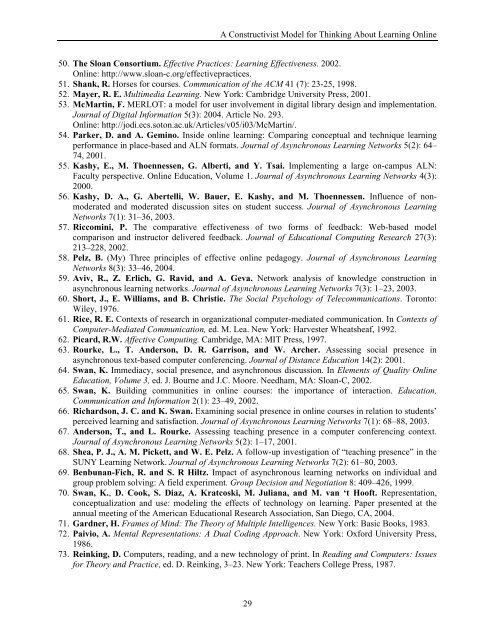Elements of Quality Online Education cation
Elements of Quality Online Education cation
Elements of Quality Online Education cation
You also want an ePaper? Increase the reach of your titles
YUMPU automatically turns print PDFs into web optimized ePapers that Google loves.
A Constructivist Model for Thinking About Learning <strong>Online</strong>50. The Sloan Consortium. Effective Practices: Learning Effectiveness. 2002.<strong>Online</strong>: http://www.sloan-c.org/effectivepractices.51. Shank, R. Horses for courses. Communi<strong>cation</strong> <strong>of</strong> the ACM 41 (7): 23-25, 1998.52. Mayer, R. E. Multimedia Learning. New York: Cambridge University Press, 2001.53. McMartin, F. MERLOT: a model for user involvement in digital library design and implementation.Journal <strong>of</strong> Digital Information 5(3): 2004. Article No. 293.<strong>Online</strong>: http://jodi.ecs.soton.ac.uk/Articles/v05/i03/McMartin/.54. Parker, D. and A. Gemino. Inside online learning: Comparing conceptual and technique learningperformance in place-based and ALN formats. Journal <strong>of</strong> Asynchronous Learning Networks 5(2): 64–74, 2001.55. Kashy, E., M. Thoennessen, G. Alberti, and Y. Tsai. Implementing a large on-campus ALN:Faculty perspective. <strong>Online</strong> <strong>Edu<strong>cation</strong></strong>, Volume 1. Journal <strong>of</strong> Asynchronous Learning Networks 4(3):2000.56. Kashy, D. A., G. Abertelli, W. Bauer, E. Kashy, and M. Thoennessen. Influence <strong>of</strong> nonmoderatedand moderated discussion sites on student success. Journal <strong>of</strong> Asynchronous LearningNetworks 7(1): 31–36, 2003.57. Riccomini, P. The comparative effectiveness <strong>of</strong> two forms <strong>of</strong> feedback: Web-based modelcomparison and instructor delivered feedback. Journal <strong>of</strong> <strong>Edu<strong>cation</strong></strong>al Computing Research 27(3):213–228, 2002.58. Pelz, B. (My) Three principles <strong>of</strong> effective online pedagogy. Journal <strong>of</strong> Asynchronous LearningNetworks 8(3): 33–46, 2004.59. Aviv, R., Z. Erlich, G. Ravid, and A. Geva. Network analysis <strong>of</strong> knowledge construction inasynchronous learning networks. Journal <strong>of</strong> Asynchronous Learning Networks 7(3): 1–23, 2003.60. Short, J., E. Williams, and B. Christie. The Social Psychology <strong>of</strong> Telecommuni<strong>cation</strong>s. Toronto:Wiley, 1976.61. Rice, R. E. Contexts <strong>of</strong> research in organizational computer-mediated communi<strong>cation</strong>. In Contexts <strong>of</strong>Computer-Mediated Communi<strong>cation</strong>, ed. M. Lea. New York: Harvester Wheatsheaf, 1992.62. Picard, R.W. Affective Computing. Cambridge, MA: MIT Press, 1997.63. Rourke, L., T. Anderson, D. R. Garrison, and W. Archer. Assessing social presence inasynchronous text-based computer conferencing. Journal <strong>of</strong> Distance <strong>Edu<strong>cation</strong></strong> 14(2): 2001.64. Swan, K. Immediacy, social presence, and asynchronous discussion. In <strong>Elements</strong> <strong>of</strong> <strong>Quality</strong> <strong>Online</strong><strong>Edu<strong>cation</strong></strong>, Volume 3, ed. J. Bourne and J.C. Moore. Needham, MA: Sloan-C, 2002.65. Swan, K. Building communities in online courses: the importance <strong>of</strong> interaction. <strong>Edu<strong>cation</strong></strong>,Communi<strong>cation</strong> and Information 2(1): 23–49, 2002.66. Richardson, J. C. and K. Swan. Examining social presence in online courses in relation to students’perceived learning and satisfaction. Journal <strong>of</strong> Asynchronous Learning Networks 7(1): 68–88, 2003.67. Anderson, T., and L. Rourke. Assessing teaching presence in a computer conferencing context.Journal <strong>of</strong> Asynchronous Learning Networks 5(2): 1–17, 2001.68. Shea, P. J., A. M. Pickett, and W. E. Pelz. A follow-up investigation <strong>of</strong> “teaching presence” in theSUNY Learning Network. Journal <strong>of</strong> Asynchronous Learning Networks 7(2): 61–80, 2003.69. Benbunan-Fich, R. and S. R Hiltz. Impact <strong>of</strong> asynchronous learning networks on individual andgroup problem solving: A field experiment. Group Decision and Negotiation 8: 409–426, 1999.70. Swan, K., D. Cook, S. Diaz, A. Kratcoski, M. Juliana, and M. van ‘t Ho<strong>of</strong>t. Representation,conceptualization and use: modeling the effects <strong>of</strong> technology on learning. Paper presented at theannual meeting <strong>of</strong> the American <strong>Edu<strong>cation</strong></strong>al Research Association, San Diego, CA, 2004.71. Gardner, H. Frames <strong>of</strong> Mind: The Theory <strong>of</strong> Multiple Intelligences. New York: Basic Books, 1983.72. Paivio, A. Mental Representations: A Dual Coding Approach. New York: Oxford University Press,1986.73. Reinking, D. Computers, reading, and a new technology <strong>of</strong> print. In Reading and Computers: Issuesfor Theory and Practice, ed. D. Reinking, 3–23. New York: Teachers College Press, 1987.29
















